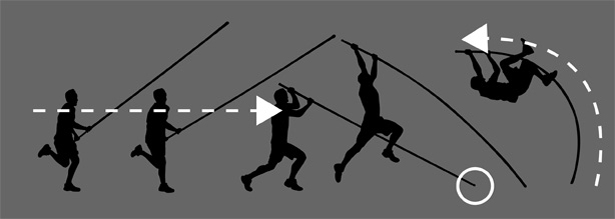Olympic Physics: The Pole Vault

Editor’s Note: The summer Olympics draw viewers to sports that they otherwise ignore. We marvel as athletes ranging from divers to pole vaulters turn power and speed into athletic artistry. Speed (velocity) and power (force) are also key elements in physics. This is the fourth in a series of guest posts by Dr. Larry Silverberg, an NC State professor of mechanical and aerospace engineering, who works in the area of engineering dynamics. He talked to NC State coaches Tom Wood (track and field), Jon Choboy (tennis), and Josh Karshen (diving) about the dynamics involved in their sports.
We’ve already talked about how strength and speed apply to the discus in track and field. While those elements also apply to the pole vault, it is a very different event. It is more complicated, requiring more stages to perfect. And each stage has its own special dynamics.
The goal in pole vault is to use a pole to launch yourself into the air and clear a horizontal bar. If you miss three consecutive vaults, you’re eliminated. The bar is raised repeatedly, and the winner is the person who clears the highest bar. The pole itself can be any length, any diameter and made of any material, though the surface must be smooth.
Using the pole, vaulters are able to reach impressive heights. The world record, set by Ukrainian Sergey Bubka, is 6.14 meters – or just over 20 feet high.
The athlete begins with a 12- to 17-step sprint on a runway that is at least 40 meters long. Next, the athlete has to plant the pole in the ground. Specifically, the pole must be planted in a box that is only one meter long. This is the most difficult part. The athlete is running at top speed and the planted end needs to stop moving in an instant.
Next, the body leans on the pole, causing it to bend. The athlete’s kinetic energy is going into the potential energy of the bent pole. Now the athlete’s momentum is used to bend the pole, creating a great deal of potential energy. When that potential energy is released, it is transferred back to the athlete – catapulting him or her in a forward/upward direction. Finally, as he is flying through the air, he starts out upside-down and rotates his body so his chest is facing down. At the peak of his trajectory, his body needs to clear the pole.
But, this is not so easy because his mass center always stays below the pole. While flying through the air he twists and contorts his body so that each part of the body is at its highest point precisely when that part is above the pole. To make matters more complicated, the athlete must also make sure that the pole doesn’t fall into the bar when he or she releases it. As you can see, the pole vault has lots of different dynamic stages to master – making it technically very complicated and wonderful to watch.
Women’s pole vault begins Aug. 4 and men’s pole vault begins Aug. 8. Here’s a link to more information on the Olympic pole vault events.
- Categories:


